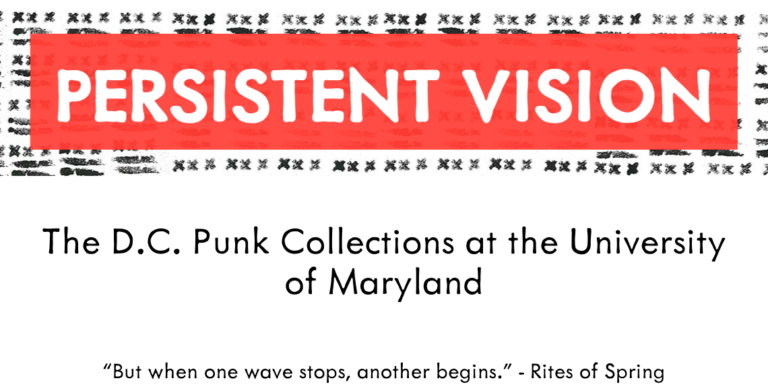
This article was a finalist in the 2022 DC Student Arts Journalism Competition. Click here to learn more about the competition.
John Davis rolled over on the short, flat couch in the live music room at WMUC’s radio station. It was 6 a.m..
He stumbled across the hall, barely awake, to the FM broadcasting studio and began hosting his show. On paper, he was a second-semester freshman at the University of Maryland, but really, he just wanted to make music.
“I was not interested in waking up at eight in the morning, so I didn’t really do that well in school.” Davis said. “But in other ways I did… I got a lot of inspiration and built this foundation that enabled me to go and play music.”
The then-17-year-old wore many hats. Any free time he had was spent completely immersed in the scene.
“I had a record label, I had a zine, I distributed records, all those things. It’s all I wanted to do all the time. I was going to shows four or five nights a week. I just completely lived in it,” he said.
In its heyday in the late ‘80s, College Park was home to multiple DIY venues and restaurants like the Varsity Grille on Route 1 and King Kong Restaurant off Adelphi that hosted punk staple bands like The Replacements, Bad Brains, and Slickee Boys.
The existence of shows like this in College Park was ever-fleeting, though. In 1979, the city attempted to ban punk bands from playing in its limits, citing the young fans with foul mouths as its reasoning. While the motion wasn’t passed, noise complaints were dealt with militantly, so by the time Davis got to UMD in the mid-’90s, these smaller shows were hard to come by.
While Stamp’s Union Grand Ballroom and Ritchie Coliseum brought powerhouse acts like the Violent Femmes, Ramones, and Fugazi, the energy of on-campus shows was more sterile, Davis said. So, many of the shows that he attended were in D.C.
“I was going to Black Cat, 9:30 Club all the time. St. Steven’s, Wilson Center, there were lots of different venues that would come and go,” he said. “That was my whole world.”
Upon graduating, all Davis wanted to do was tour with his band, and he did.
Q and Not U, his post-punk group, amassed a decent amount of success. Even today, the band maintains nearly 15,000 monthly listeners on Spotify.
After putting out three studio albums, touring the world, and losing a bassist along the way, the band realized it was time to part ways. Davis wanted to find a path that encompassed his love for D.C. music in the same way he was able to both as a student and in his band. He found himself right back where he started, at the University of Maryland, but this time as a librarian and curator for the Special Collections in Performing Arts.
John Davis now sits in a button-up and khaki slacks in his office at the Clarice. He doesn’t walk around with a crusty leather jacket or black painted nails, he looks like just a regular librarian, a scholar. The unsuspecting passerby would never guess that his research was in punk history, something traditionally not associated with academia.
Davis noticed that institutions like New York University, Duke University, and the University of Iowa were emerging with new research on early fanzines and punk and rock music cultures. In 2015, he pitched a similar concept— one that showcased the history of the punk and alternative music scene in D.C.. With a green light from the department, he got to work on a project that would eventually become a multi-part digital exhibit: Persistent Vision— The D.C. Punk Collections at UMD.
Where does one even start when documenting over 40 years of rich subculture? For Davis, it began by dusting off his old fanzines.
“I donated my own stuff first,” he said. “Then, I just started asking around— ‘any chance you have any extra fanzines? Other materials you would like to donate?’”
After tireless efforts through mutual connections and social media followers, Davis realized that there were more materials willing to be given to him outside of fanzines, fliers, photos, recordings, all allowing him to better encapsulate what it was like during the rise of DMV punk.
“What people have been able to do within their limitations is so fascinating to see,” Davis said.
The collection is divided into five sections— Punk at UMD, DMV punk history from 1976-79, 1980-89, 1990-92, and 1993-present, which is still a work in progress.
Alongside the emergence of go-go, a genre with roots in funk and hip-hop, according to the collection, in the late ‘70s, punk rock was born in D.C.. Local act Slickee Boys is seen as a staple to this era, playing multiple shows with other emerging punk bands at a venue just blocks from the National Mall, d.c. space, which has since been turned into a Starbucks.
The ‘80s were a time of transformation for the scene, producing a more hard and fast strain of music from bands like Government Issue, State of Alert, and Minor threat who, according to the collection, “completely [reshaped] the D.C. and national punk scenes.”
“I think D.C. will define the ‘90s [punk era],” Ian Svenonius, singer in the band Nation of Ulysses, said in a 1990 interview with Sassy Magazine.
And it would. Intertwining with the emergence of the indie scene, punks became more creative and connected, making networks of artists that allowed the scene to blow up on a national scale. Even still, they were rooted in their local community.
Punks use their music as agents of change against social problems, and D.C. was no different.
Amidst increasing drug-related violence and decreasing social services, D.C. punks became more upset by the climate they were experiencing in their city. That anger was channeled into raising money and awareness for not only these issues, but issues nationwide, like U.S. military intervention in El Salvador and the AIDS crisis. Through their zines, music, and organizing, real change was happening at the hands of the punk community. The empowerment streaming out of this subculture is part of the reason why Davis found himself so enamored by it in the first place. It’s resonant in the collection’s name itself, “Persistent Vision,” which is drawn from a lyric of local punk rock band Rites of Spring.
“The title speaks to how consistently throughout the history of this community, there has been a forward-looking vision and people who wanted to do new things, try things differently, and push against all of the boundaries in music and culture, and everything, really,” he said.
There’s still more to be added to the collection, too. Once the D.C. scene rose to grand-scale fame, it only inspired those involved to do more and get even better. The ‘90s and 2010s were very active periods of the community, according to Davis, and as such he and his research team have a lot of material to comb through.
And it doesn’t end there. Even now, the punk community continues to thrive in the DMV.
According to Davis, the barriers of entry are low, meaning anyone can get involved.
“There’s something about punk that speaks to people, that keeps bringing more people in, that keeps it moving forward,” he said. “Whether it’s putting on shows, or making music or making a zine, you just have got to do it with whatever you have available.”

Molly Szymanski is a third-year journalism student at the University of Maryland, College Park, most interested in covering the local music scene and stories from the fringes of the community. When not writing, they can be found wreaking havoc at WMUC, Maryland’s college radio station, or hanging out with their cat, Buckwheat.